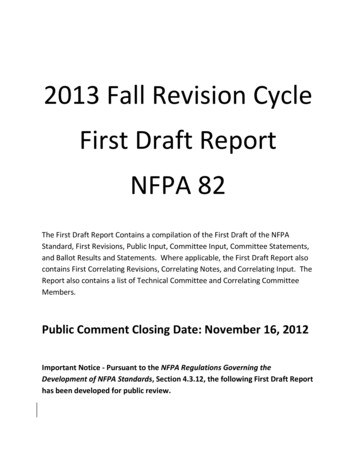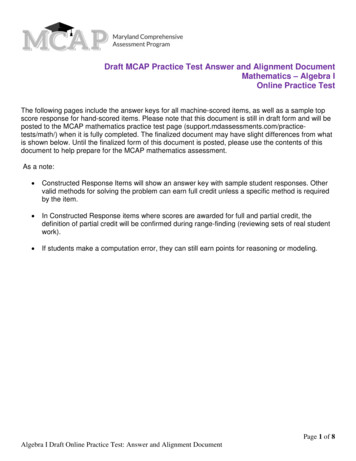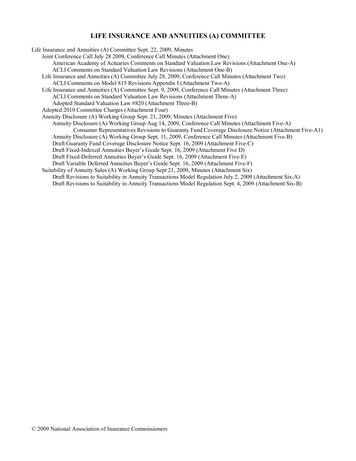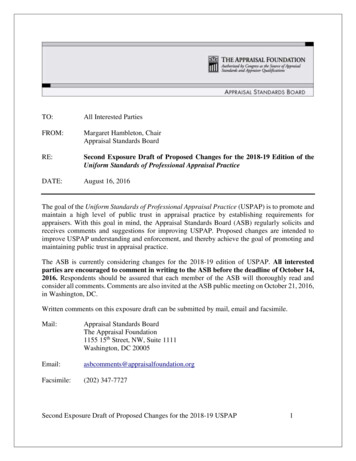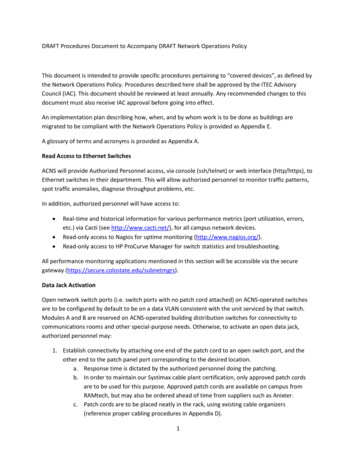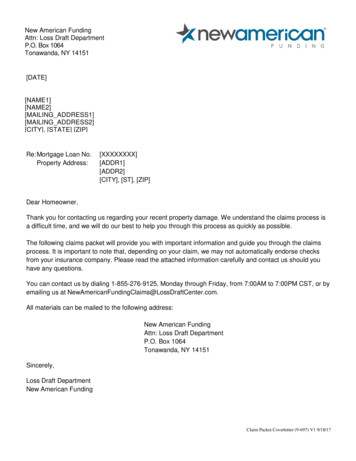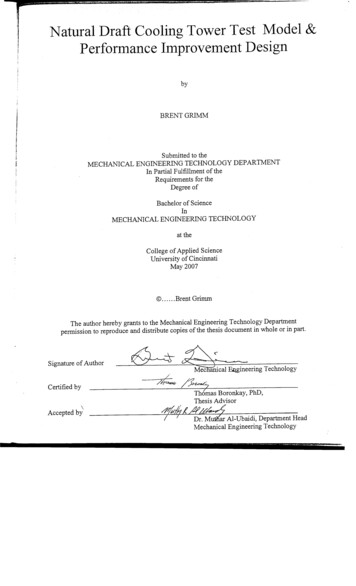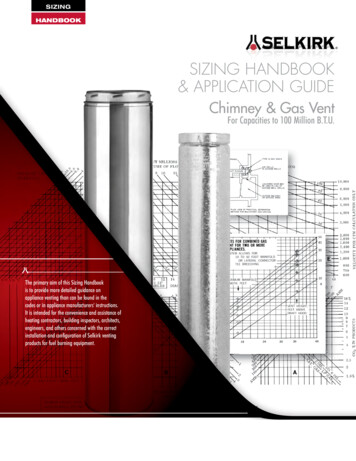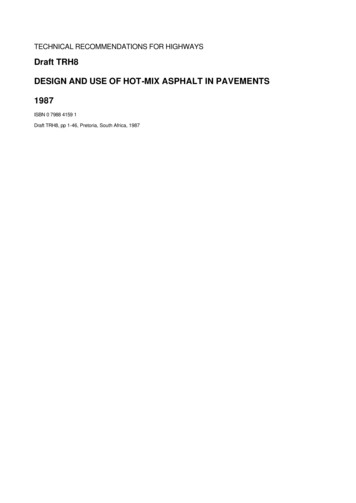
Transcription
TECHNICAL RECOMMENDATIONS FOR HIGHWAYSDraft TRH8DESIGN AND USE OF HOT-MIX ASPHALT IN PAVEMENTS1987ISBN 0 7988 4159 1Draft TRH8, pp 1-46, Pretoria, South Africa, 1987
Published byDepartment of TransportP O Box 415PRETORIA0001Republic of South AfricaREPRINTED 1989Printed in theRepublic of South Africaby V & R Printing Works (Pty) Ltd.PRETORIA
PREFACETECHNICAL RECOMMENDATIONS FOR HIGHWAYS (TRH) are written for the practising engineer anddescribe current, recommended practice in selected aspects of highway engineering. They are based onSouth African experience and the results of research and have the full support and approval of theCommittee of State Roads Authorities (CSRA).To confirm their validity in practice, TRHs are circulated in draft form for a period of trial before beingsubmitted to the CSRA for approval. This document, Draft TRH8, will therefore be in use for a limited periodduring which you are welcome to send suggestions for improvement to the Chief Director, National Institutefor Transport and Road Research, P O Box 395, Pretoria 0001. Eventually a revised document, approved bythe CSRA, will be issued as a full TRH in both languages.NoteThis document is published by the National Institute for Transport and Road Research for and with theapproval of the Highway Materials Committee of the Committee of State Roads Authorities.
SYNOPSISHot-mix asphalt has been used extensively in South Africa since the 1920s to provide bases, surfacings, andoverlays for pavement construction and rehabilitation. Increased application of the material, together with thelarge growth in traffic has placed heavy demands on its engineering properties; both these properties andtheir applications are discussed.The various types of hot-mix asphalt (gap-, semi-gap- and continuously-graded asphalt, dense bitumenmacadam and open-graded asphalt) are reviewed. Suggestions are made as to the most effective selectionof a particular type of asphalt for a specific situation, consideration being given to functions, properties andperformance.The section on mix design covers materials, mix design procedures and criteria, as well as the particulardesign considerations relating to airports and parking areas.SINOPSISWarmmengasfalt is sedert die twintigerjare op ‘n uitgebreide grondslag in Suid-Afrika gebruik om kroonlae,deklae en herdeklae vir plaveiselkonstruksie en -vernuwing te voorsien. ‘n Toename in die gebruik van diemateriaal tesame met die groot toename in verkeer het groot eise aan die ingenieurswetenskappe daarvangestel; sowel hierdie eienskappe as die toepassing daarvan word bespreek.Die onderskeie tipes warmmengasfalt (aaneengegradeerde, sprong- en semi-spronggegradeerde asfalt,digte bitumenmacadam en oopgegradeerde asfalt) word beskou. Voorstelle word gemaak rakende die meesdoeltreffende keuse van ‘n spesifieke tipe asfalt vir ‘n spesifieke situasie, terwyl oorweging geskenk wordaan funksies, eienskappe en prestasie.Die afdeling oor mengontwerp dek materiale, mengontwerpprosedures en maatstawwe, asook die spesifiekeontwerpoorwegings wat betrekking het op lughawens en parkeerterreine.KEYWORDSHot-mix asphalt, mix design, design criteria, surfacing, base layer, levelling course, aggregate.INTRODUCTIONBackgroundThe use of hot-mix asphalt in South Africa dates back to the 1920s when the larger cities felt the need formore durable surfacing materials to pave their increasingly heavily trafficked streets. The use of this materialhas steadily increased since then, stimulated by the development of modern roads and airports over the last130 years. These developments led in 1978 to the compilation of Draft TRH8 which dealt with the selectionand design of hot-mix asphalt surfacings for roads. At present, hot-mix asphalt is used extensively for basesand surfacings for new construction, as well as for overlays in the maintenance and rehabilitation of existingpavements. All in all, about two million tons of hot-mix asphalt are used annually in South Africa. This wideapplication of the material, together with the substantial growth in traffic (in both the number of vehicles andtheir mass), has placed correspondingly higher demands on its engineering properties. It has therefore1become necessary to update and extend the scope of the previous document .The information contained in this guide has been compiled from various sources. These include: theexperience of the major road authorities, the asphalt industry and other institutions; experimental work andresearch studies undertaken by the National Institute for Transport and Road Research (NITRR) anduniversities; published literature and members of the consulting civil engineering profession.ScopeThis document is aimed at providing guidelines for the economical design and use of hot-mix asphalt inpavements (i.e. roads, airfields and parking areas). Attention is drawn to the fact that only hot mixes arecovered; cold-laid asphalt such as bitumen emulsion mixes are not included. Many of the principlescontained in this document, however, also relate to other forms of asphalt mixes. The layout of this documentis given in Figure 1.
CONTENTSPREFACE . 3SYNOPSIS . 4SINOPSIS . 4INTRODUCTION . 4Background. 4Scope . 41THE HOT-MIX PROCESS . 72ENGINEERING PROPERTIES OF HOT-MIX ASPHALT . 92.1DURABILITY . 92.2RESISTANCE TO CRACKING. 92.3RESISTANCE TO PLASTIC DEFORMATION .102.4RESISTANCE TO SHRINKAGE .102.5FLEXIBILTY .102.6SKID RESISTANCE .102.7PERMEABILITY .112.8STIFFNESS (ELASTIC MODULUS) .112.9WORKABILITY .113TYPES OF HOT-MIX ASPHALT AND THEIR MOST IMPORTANT PROPERTIES .123.1GAP-GRADED AND SEMI-GAP-GRADED ASPHALTS .123.2CONTINUOUSLY-GRADED ASPHALT .133.3DENSE BITUMEN MACADAM (DBM) .133.4OPEN-GRADED ASPHALT .134SELECTION OF A HOT-MIX ASPHALT TO SUIT SPECIFIC REQUIREMENTS .154.1SURFACINGS.154.1.1Functions and properties .154.1.2Performance.154.1.3Selection of mix type for surfacings .154.2BASES .154.2.1Functions and properties .154.2.2Performance.164.2.3Selection of mix type for base layers .165MIX DESIGN .175.1MATERIALS .175.1.1Aggregate .175.1.2Coarse aggregate.185.1.3Fine aggregate .185.1.4Filler .185.1.5Binder.195.2MIX DESIGN PROCEDURES AND CRITERIA .195.2.1Design of gap-, semi-gap-, and continuously-graded mixes .215.2.2Design of DBM mixes.245.2.3Design of open-graded mixes .265.3SPECIAL DESIGN CONSIDERATIONS FOR AIRPORTS AND PARKING AREAS.266QUALITY ASSURANCE .27REFERENCES .28FURTHER READING.28DEFINITIONS.29APPENDIX A :Blending of various stone sizes to a given aggregate grading.31APPENDIX B :Calculation of binder film thickness.34APPENDIX C :Determination of the air permeability of compacted Marshall specimens .35APPENDIX D :Design method for open-graded asphalt .38LIST OF FIGURESFIGURE 1 Diagrammatic representation of the layout of this document . 8FIGURE 2 Bureau of Public Roads chart for aggregate gradation analysis .23
FIGURE 3 Grading curves resulting from the relationship?100 ? F ?d n ? 0,075 n ?P?Dn? 0,075 n?F .25FIGURE A1 Aggregate blending chart – Rothfuchs’s method.32FIGURE C1 Measurement of the air permeability of compacted Marshall specimens using the AsphaltPaving Meter .37FIGURE D1 Chart for determining the surface constant (K C ) of coarse aggregate .39LIST OF TABLESTABLE 1 Typical ratings of the five asphalt types in terms of engineering properties .12TABLE 2 Required physical properties of aggregate fractions .17TABLE 3 Grading envelopes and nominal mix proportions for surfacing mixtures .20TABLE 4 Grading envelopes and nominal mix proportions for bases .21TABLE 5 Test requirements of gap-, semi-gap-, and continuously-graded mixes* .22TABLE 6 Recommended minimum voids in mineral aggregate (VMA) values for continuously-graded mixes.24TABLE A1 Particle-size distribution of components on the basis of wet analysis .31TABLE A2 Theoretical blend resulting from Rothfuchs's method .33
1THE HOT-MIX PROCESSIn the hot-mix process aggregate is dried and heated. It is then mixed in accurate proportions with binder andfiller so that all particles are coated with a more or less uniform film of the binder. This binder is heated toensure the low viscosity needed for thorough mixing.Accurate control of the mixing process is necessary, and therefore most asphalt mixes are produced inasphalt plants. Two types of plant are generally used: the batch mixer and the drum mixer. The former mixesa batch of aggregate and binder in accurately weighed proportions in a pugmill mixer, discharging the mixbefore the next batch of ingredients is introduced into the mixer. The latter mixes accurately proportionedvolumes of aggregate and binder in a continuous flow from one end of the rotating drum to the other, wherethe mixture is discharged into a truck or a hot storage hopper.Once the mixing process has been completed, the hot-mix is transported to the site. It is laid with a pavingmachine in a semi-compacted layer to give a uniform, even surface. While the mixture is still hot, it is furthercompacted by heavy self-propelled rollers. Controls during the mixing and laying process have a directbearing on the quality of the product.Additional macrotexturing may be required in order to improve the skid resistance of certain types ofsurfacing mixes. If this is the case, precoated chips can be spread and rolled into the still warm surface.
FIGURE 1 Diagrammatic representation of the layout of this document
2ENGINEERING PROPERTIES OF HOT-MIX ASPHALTA successful hot-mix asphalt has a number of properties, the three primary ones being:? durability;? resistance to cracking and? resistance to permanent deformation.The mix design process is therefore essentially directed towards producing a durable mix which will exhibitminimal cracking and deformation during its design life. The emphasis placed on secondary properties suchas flexibility, skid resistance and impermeability to water will depend on the specific function required of thehot-mix asphalt layer in the pavement.The various properties are discussed briefly below; from the discussion it will be evident that some of theconditions required for optimizing particular properties are incompatible with those required for otherproperties. In practice, therefore, the best mix design for a particular application is often dictated by the needto achieve a balance between properties.2.1DURABILITYThe durability of a hot-mix asphalt layer can be defined as its ability to resist:?adverse changes to the binder (e.g. hardening due to oxidation, loss of volatiles and polymerization);disintegration of the aggregate;stripping of bitumen from the aggregate andthe action of traffic.The most important factors adversely affecting durability (usually in combination) are high surfacetemperatures and the action of water, sunlight and traffic.Poor durability normally results in pitting, sanding or ravelling of the surface; brittleness and early cracking;loss or displacement of the binder film, and potholes.Experience has shown that durability can be improved by using the most appropriate binder in relatively thickfilms, dense aggregate packings (i.e. relatively low voids in the mineral aggregate) and sound, durableaggregate which resists stripping of the binder films.The durability of a mix cannot be measured directly. It is assessed during the mix design phase (see Section6) using parameters such as binder content, binder film thickness, type of binder, air voids, air permeability,aggregate grading and quality, and mix density.2.2RESISTANCE TO CRACKINGResistance to cracking depends on tensile strength, i.e. the ability to withstand a tensile stress andaccompanying strains without cracking. The tensile strength of asphalt is progressively reduced by repeatedstressing. This results in accumulated strain, a process known as fatiguing. Failure in tension will thus occurwhenever an applied or induced tensile stress exceeds the tensile strength, which may have been reducedby fatiguing.Forces causing cracking of an asphalt layer may result from the action of traffic or from other, non-trafficfactors. Repeated deflection under the passage of many heavy wheel loads can gradually fatigue an asphaltlayer. Failure may then occur. However, an asphalt layer can also be stressed by volume changes in thelayer itself or in supporting layers (i.e. thermal and shrinkage forces). Permanent settlement or heave oflower-laying layers may have the same result.The ability of asphalt layers to resist cracking therefore needs to be assessed in conjunction with the rest ofthe pavement structure. Both the thickness and the stiffness of the asphalt layers in relation to those of thesupporting layers have a direct bearing on the induced stresses and strains, and therefore affect resistanceto cracking. The role of asphalt stiffness is further referred to in Section 2.8.
The fatigue lives of the different asphalt mix types have been assessed in the laboratory (Table 1). However,these lives have been determined independently of the properties of the supporting layers, and cannottherefore be used directly to select a suitable asphalt mix type. A mechanistic evaluation of the wholestructure is thus recommended before the final selection of mix type is made. In general, it can be stated thatmixes with relatively low stiffness values should be used for thin asphalt surfacings supported by granularlayers, whereas stiff asphalt is generally required when used for thick base layers.2.3RESISTANCE TO PLASTIC DEFORMATIONThe ability of hot-mix asphalt to resist permanent deformation under repeated or static loads depends on thefollowing factors:? frictional resistance;? cohesion (or tensile strength) and? inertia.Of these, frictional resistance is the major contributor to deformation resistance. Plastic deformation in ahot-mix asphalt layer is normally a creep phenomenon. Local experience has shown that it is likely to occurwhen high road surface temperatures ( 40 ºC) are combined with high traffic loading. It should be noted thatroad surface temperatures in excess of 60 ºC are not unusual in South Africa during the summer.Manifestations of poor resistance to deformation are channelling (ruts), corrugations, and shoving.Resistance to plastic deformation can be improved by the selection of a dense aggregate packing, arelatively low binder content and a high-viscosity binder, and by ensuring proper bonding to the underlyinglayer and sufficient compaction during construction. The creep test and related criteria can be used duringthe mix design phase to assess the ability of a mix to resist plastic deformation.2.4RESISTANCE TO SHRINKAGEShrinkage can be caused by temperature-related volume changes, the absorption of binder by theaggregate, the ageing of the binder, or by a combination of these factors. Shrinkage cracking is more likely tooccur in dry areas with marked temperature changes. Factors which will improve resistance to shrinkagecracking are the same as those that promote durability - for example, dense aggregate packing. Recentresearch has indicated that shrinkage is inversely proportional to the voids in the mineral aggregate (VMA)and directly proportional to the tensile strength of the mix. These proportions may therefore be used toassess the shrinkage potential of a mix at the design stage.2.5FLEXIBILTYFlexibility can be defined as the ability of an asphalt layer to adapt to long-term variations in the pavementprofile without cracking. An example of long-term variation in pavement profile which must be accommodatedby an asphalt surfacing is that which results from non-uniform consolidation of underlying pavement layersunder the action of traffic.Systematic studies in this area of asphalt behaviour have shown that flexibility is promoted by high bindercontents and/or comparatively open aggregate gradings. Flexibility is assessed indirectly by mix designparameters such as binder content, binder type and aggregate grading.2.6SKID RESISTANCESkid resistance is that property of a pavement surface by which the traction between tyres and surface ismaintained. It is of particular importance in wet conditions.The development of surfaces with a high skid resistance when wet is of prime importance to road safety.Skid resistance is promoted by ensuring adequate air voids to prevent bleeding and by using aggregateswith rough surface textures. The aggregate must also be resistant to the polishing action of traffic. The mostsuitable aggregates from this point of view are those containing minerals with different wear characteristics.Under the action of traffic, an aggregate of this type will continually have its rough surface texture renewed.This provides the sharp, coarse-grained microtexture necessary for effective contact between the tyre andthe pavement surface.
2.7PERMEABILITYThe permeability of an asphalt mix is that property which allows penetration of the mix by air, water andwater vapour. Low permeability of a surfacing promotes long-term durability and protects the supportinglayers from the ingress of water. Low permeability also limits the rate of transfer of oxygen, micro-organismsand volatile constituents through the asphalt layer.The same factors which promote durability also ensure impermeability, i.e. high binder content, adequate filmthickness, dense aggregate gradation, well-compacted mixtures and the dispersion of the air voids within themix. However, an open-textured and therefore permeable surfacing may be needed in order to improve skidresistance and to reduce splash and spray from vehicles in wet weather. Such a surface should always belaid over an impermeable supporting layer.The permeability of a mix can be measured during the mix design phase (see Appendix C). The air-82permeability of asphalt surfacings should not exceed 1 x 10 cm .2.8STIFFNESS (ELASTIC MODULUS)The stiffness of a hot-mix asphalt layer determines the ability of the layer to carry and spread traffic loads. Itis often expressed in terms of the elastic modulus of the material. The elastic modulus of hot-mix asphaltranges from 600 to 6 000 MPa, with an average of 2 500 MPa. Stresses are concentrated in relatively stifflayers, particularly when these layers are close to the surface of the pavement.The ratio of the stiffness of the asphalt layer to that of the supporting layers is important. Thin, stiff asphaltlayers supported by weak base layers are to be avoided. Stiff asphalt is generally required for base layers.Less well supported surfacings may be better served by a lower stiffness in order to avoid excessivetraffic-induced stresses which would lead to early cracking.Stiffness is increased by selecting a dense aggregate packing, the optimum binder content and high viscositybinders, and by ensuring good compaction. Normally, because of the complicated equipment required,stiffness is not measured in the mix design phase. It is controlled indirectly by the selection of the mix andbinder type.2.9WORKABILITYWorkability is that property which facilitates the handling, spreading and compaction of a hot asphalt. It isimperative that, even under adverse conditions, a mix will spread easily and compact sufficiently well in orderto provide a durable layer. Mix variables that influence workability are: binder content, viscosity and settingproperties; aggregate grading, shape and type, and the temperature of the mix at the time of handling.Workability is usually improved by an increase in binder content, a decrease in binder viscosity, the use ofless angular aggregates, and by limiting the maximum stone size to half the asphalt layer thickness. Tearingmay occur when the coarse aggregate fraction is very high. This risk is particularly high when laying thinlayers. Tender mixes can be improved by adjusting the aggregate grading and/or by the addition of anabsorbent filler such as hydrated lime.
3TYPES OF HOT-MIX ASPHALT AND THEIR MOST IMPORTANT PROPERTIESHot-mix asphalt may be designed and produced from many different aggregate types, a wide range ofaggregate size combinations and various binder types. Each mix has its own particular properties whichmake it suitable for specific conditions of use. Hot-mix asphalts are normally distinguished by aggregategrading; for the purpose of this document they are broadly classified into five mix types, i.e. gap-graded,semi-gap-graded, continuously-graded, dense bitumen macadam (DBM), and open-graded mixes.All these mixes can be produced using a blend of new and reclaimed materials. Such mixes are prefixed bythe term 'recycled', e.g. recycled continuously-graded asphalt. Hot-mix asphalt is generally produced using apenetration grade bitumen or, at times, low-volatile tar. Modified binders that can be used include bitumenrubber and polymer-modified binders. An asphalt mix is normally modified to improve one or more of theengineering properties such as durability, fatigue resistance and resistance to plastic deformation. The use ofa modified binder is sometimes accompanied by a modification to the aggregate grading. This would, forexample, allow these mixes to accommodate more binder, thereby improving their flexibility and crackresistance.However, experience in the long-term performance of modified mixes is limited and mix design proceduresand criteria are not well defined. Consequently, the use of modified mixes is often preceded by research andextensive laboratory testing, though the design criteria for conventional mixes are generally used asguidelines.Modified mixes should not be used when conventional products provide adequate engineering properties. Itis also evident from the uncertainties related to the long-term performance and design criteria of modifiedmixes that these mixes should be used with discretion.Table 1 compares the engineering properties of the five mix types in broad terms. The comparison is madeon an escalating performance scale of 1 to 5. Asphalt properties depend on many factors other thanaggregate grading. A low rating for a particular engineering property does not therefore necessarily implythat the asphalt type cannot be designed to accommodate this inadequacy.TABLE 1 Typical ratings of the five asphalt types in terms of engineering properties(1 poor and 5 gradedgradedbitumengradedmacadamMix property:Durability3 to 444 to 531Tensile strength34541Fatigue*4 to 54324resistanceDeformation2 to 33 to 44 to 553resistanceImpermeability543 to 421to water††Skid resistance453–5Workability44425Stiffness344 to 551Shrinkage34554*Tested in the constant strain mode. Note: actual fatigue life depends on layer thickness, stiffness andsupport condition.†With precoated rolled-in chips.3.1GAP-GRADED AND SEMI-GAP-GRADED ASPHALTSAs the names imply, gap-graded and semi-gap-graded asphalts have a certain range of particle sizesmissing from the total aggregate grading.
Gap-graded asphalt consists of coarse aggregate of a fairly uniform size blended with fine aggregate andfiller, while semi-gap-graded asphalt consists of a more graded coarse aggregate blended with fineaggregate and filler. Both types of mix have been used with great success in South Africa as surfacings,bases and overlays.Research studies carded out at the NITRR have indicated that gap-graded and semi-gap-graded mixes aresuperior to more densely graded mixes as regards fatigue resistance. In practice, however, this will dependon the combination of layer thicknesses. For certain layer thickness combinations the strains in morecontinuously-graded mixes may be lower, owing to their increased stiffness. This can result in similar orhigher fatigue lives for densely graded mixes than for gap-graded mixes.Recent in-service experience and controlled accelerated trafficking by the Heavy Vehicle Simulator (HVS)have indicated that with certain materials it may be difficult to design gap-graded mixes that possesssufficient resistance to plastic deformation under heavy traffic conditions. The quality of sand (or fineaggregate) is of particu
Hot-mix asphalt, mix design, design criteria, surfacing, base layer, levelling course, aggregate. INTRODUCTION Background The use of hot-mix asphalt in South Africa dates back to the 1920s when the larger cities felt the need for more durable surfacing materials to pave their increasingly heavily trafficked streets. The use of this material

